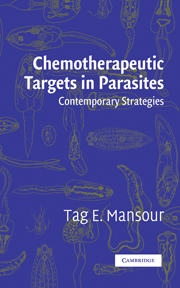Book contents
- Frontmatter
- Contents
- Preface
- Acknowledgments
- 1 The Search for Antiparasitic Agents
- 2 Biophysical, Genomic, and Proteomic Analysis of Drug Targets
- 3 Energy Metabolism in Parasitic Helminths: Targets for Antiparasitic Agents
- 4 Antimalarial Agents and Their Targets
- 5 Antitrypanosomal and Antileishmanial Targets
- 6 Targets in Amitochondrial Protists
- 7 Neuromuscular Structures and Microtubules as Targets
- 8 Targets in the Tegument of Flatworms
- Epilogue
- Index
- References
3 - Energy Metabolism in Parasitic Helminths: Targets for Antiparasitic Agents
Published online by Cambridge University Press: 11 August 2009
- Frontmatter
- Contents
- Preface
- Acknowledgments
- 1 The Search for Antiparasitic Agents
- 2 Biophysical, Genomic, and Proteomic Analysis of Drug Targets
- 3 Energy Metabolism in Parasitic Helminths: Targets for Antiparasitic Agents
- 4 Antimalarial Agents and Their Targets
- 5 Antitrypanosomal and Antileishmanial Targets
- 6 Targets in Amitochondrial Protists
- 7 Neuromuscular Structures and Microtubules as Targets
- 8 Targets in the Tegument of Flatworms
- Epilogue
- Index
- References
Summary
During the first half of the twentieth century studies on the biochemistry of energy production showed that there are great similarities among diverse species. The discoveries of complex pathways and the details of the enzymes involved encouraged biochemists to investigate the metabolism of many different parasites. Pharmacologists who were interested in the chemotherapy of these parasites looked at these studies as a way of finding reactions that are unique to the parasite and that the enzymes catalyzing these reactions could be targets for new antiparasitic agents.
Glucose and/or glycogen constitute the main sources of energy to produce ATP for parasitic helminths. When these parasites live in a milieu that is rich with sugars their metabolism is adapted to utilizing large amounts of glucose. They resort to the inefficient degradation of glucose through anaerobic metabolism, which produces only low levels of ATP plus excreted metabolic products such as lactic acid and/or fatty acids. The utilization of large amounts of glucose compensates for the inefficient nature of the parasites' anaerobic metabolism. Many antiparasitic agents owe their successful antiparasitic action to a selective inhibition of energy production by the parasite. A good understanding of the nature of different carbohydrate metabolic reactions in parasitic helminths is a solid basis for choosing appropriate targets for new chemotherapeutic agents.
Life Cycles of Representative Helminths
Although this chapter focuses on the adult stages of the parasites discussed, a brief description of the life cycles of three representative species is included.
- Type
- Chapter
- Information
- Chemotherapeutic Targets in ParasitesContemporary Strategies, pp. 33 - 57Publisher: Cambridge University PressPrint publication year: 2002
References
- 1
- Cited by



